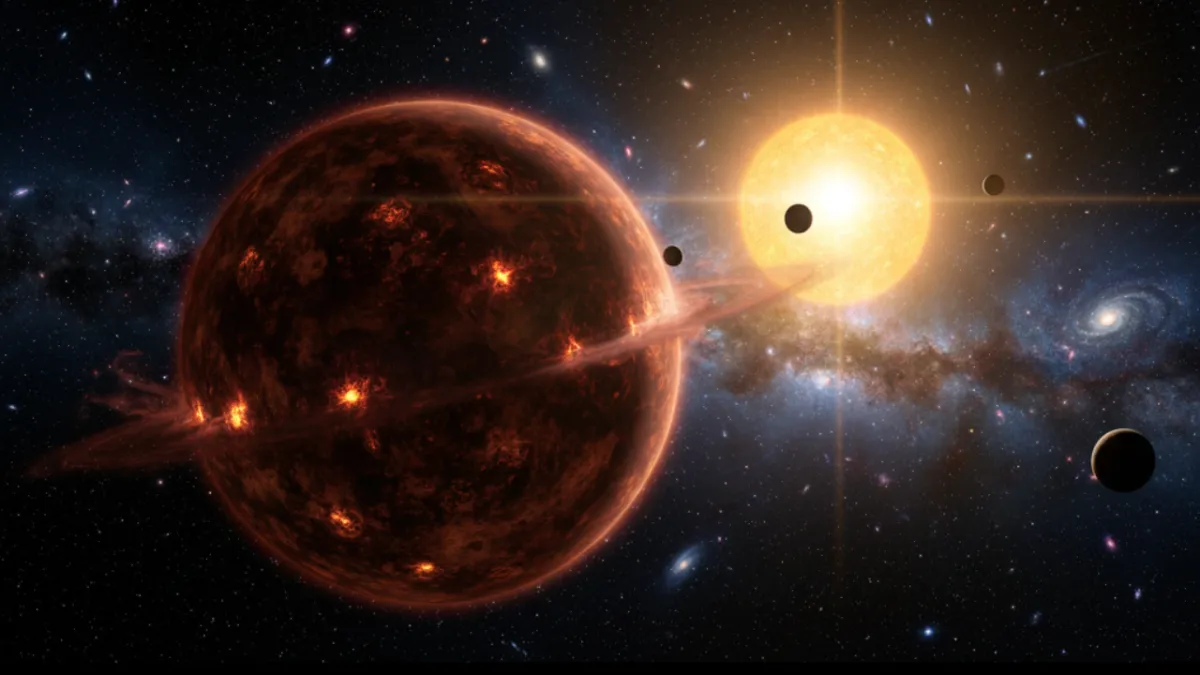| Summary |
|
Astronomers have found phosphine gas in the atmosphere of a brown dwarf named Wolf 1130C, about 55 light-years away. The signal comes from new James Webb Space Telescope (JWST) data and matches predicted levels for the first time. The find helps explain why other cool objects in space appear to lack this gas, even though models say it should be present.
Brown dwarfs sit between planets and stars. They are too small to shine through steady hydrogen fusion but too large to count as planets. Wolf 1130C is one of the cooler examples, with a temperature of around 600 Kelvin. It has a mass about 40 times greater than Jupiter and a similar size.
The system that hosts it is unusual. Wolf 1130 includes a close pair: a small red dwarf star and a white dwarf formed from an older star. Wolf 1130C moves far from that pair, at a distance thousands of times greater than the space between Earth and the Sun. The entire system belongs to an old region of the Milky Way known as the thick disk. Stars in this region contain fewer heavy elements than younger stars closer to us.
That low metal level turns out to be key. Heavy elements like iron and phosphorus formed in earlier stellar explosions. Many older stars have less iron, but some show higher phosphorus than expected. Wolf 1130C appears to be one of them.
JWST used two instruments to study the object. First, the NIRSpec spectrograph recorded infrared light between 0.6 and 5.2 microns. Then, MIRI mapped longer wavelengths. Together, they produced clean signals with high clarity, letting scientists separate Wolf 1130C’s light from the bright pair nearby.
In that data, researchers saw a small dip at a wavelength around 4.3 microns. That dip matches a pattern caused by phosphine gas. It includes several narrow features that rule out carbon dioxide, which can mimic this signal. Models that assume still, unchanging layers in the atmosphere fail to produce phosphine. But when mixing is added, the match becomes clear.
The levels detected reach about 0.1 parts per million. That is 100 times higher than readings for another cold brown dwarf called WISE 0855-0714. It also lines up closely with predictions made before the observation.
On Jupiter and Saturn, phosphine rises from deeper, hotter layers. Under calm conditions it would break apart, so its presence points to strong mixing. Until now, brown dwarfs and giant planets outside our solar system only showed upper limits, far below predicted levels. In many cases, carbon dioxide blocks the signal scientists look for.
Wolf 1130C appears different. Its low metal level cuts carbon dioxide to tiny amounts. That opens a clear window where phosphine can be seen. Low metals change other chemistry too. A salt that normally removes phosphine forms deeper in the atmosphere, letting some phosphine reach higher layers instead of disappearing.
The data also suggest that water, methane, and hydrogen sulfide match simple expectations. Carbon monoxide and phosphine do not, which again supports strong mixing. Carbon dioxide comes in far below one part per billion.
The phosphorus level matches what astronomers see in other thick-disk stars, where it can be higher than iron. It could come from ancient supernova explosions that enriched some parts of the galaxy or past activity from the white dwarf in the system.
The result matters for studies of distant planets. Phosphine once raised excitement on Venus as a possible sign of life, until later work showed non-biological ways to make it. Wolf 1130C is a clear example of a lifeless world that produces it through normal chemistry and motion in its atmosphere.
Researchers plan to examine more cold objects using JWST. Early results have already found clear carbon dioxide on a hot planet called WASP-39b. With more data, astronomers hope to learn how common phosphine is and what that says about weather and chemistry on planets and brown dwarfs across our galaxy.

